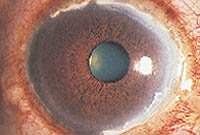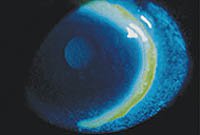Link between Mooren’s ulcer, hepatitis C is questioned
Associated flaviviruses could cause corneal problems, yet go undetected by available tests.
SAN FRANCISCO — Hepatitis C is not always found in Mooren’s ulcer patients, but associated flaviviruses may still trigger the pernicious condition that leads to perforations.
Emmett T. Cunningham Jr., MD, PhD, MPH, director of the uveitis service at the Francis I. Proctor Foundation, examined patients in south India to learn what causal factors were associated with the disease.
Although rare in the United States, Mooren’s ulcer is fairly common in developing countries, he said. He concluded from his study that because Mooren’s ulcers are unrelated to hepatitis C or herpes simplex virus, physicians who see Mooren’s ulcer can focus their efforts elsewhere in treating the condition.
“The fact that we feel pretty strongly that it’s not related to hepatitis C means we don’t have to investigate for hepatitis C and worry about that when you use systemic immunosuppressive agents,” he said. “Obviously, if you have an underlying chronic viral illness, you worry a bit about giving someone potent immunosuppressive medicines. Now people can use whatever they need to use to control the disorder.”
However, Steven E. Wilson, MD, said that although patients may not have hepatitis C, they could still have an associated infection that remains undetected yet still triggers Mooren’s ulcers. A genetic susceptibility also may provide a one-two punch, which would further dilute the results of a study limited to a single, isolated population such as south India’s.
Disputed link
 ---Slit lamp photo of Mooren’s-like ulcer in a patient with hepatitis C virus chronic active hepatitis.
---Slit lamp photo of Mooren’s-like ulcer in a patient with hepatitis C virus chronic active hepatitis.
PHOTOGRAPH COURTESY OF STEVEN E. WILSON, MD.
Dr. Cunningham practices at The Proctor Foundation at the University of California, San Francisco, which conducts long standing collaborative studies in India. Mooren’s ulcer is a painful, pernicious disease that causes blindness by perforating the cornea. It may be more common in developing countries because the risk factors that have been implicated are more common in that part of the world, he said.
Mooren’s ulcer became connected with hepatitis C after Dr. Wilson conducted and published small-scale studies of patients with the disease. Treatments with interferon improved the corneal disease in three patients, suggesting the link.
Dr. Cunningham conducted his study to find the rate of undiagnosed hepatitis C in Mooren’s ulcer patients.
Researchers surveyed 50 patients diagnosed with Mooren’s ulcer at the Cornea Clinic of the Aravind Eye Hospital in Madurai, India, within the previous year. Of this group, 20 patients returned to the clinic and one new case was diagnosed in that period. The control group was 40 patients scheduled for cataract surgery and four of the hospital staff.
Patients underwent an exam and blood tests for antinuclear antibodies, antineutrophil cytoplasmic antibodies, rheumatoid factors, herpes simplex virus and hepatitis C. Patients showed no correlation between any of these serologic tests and Mooren’s ulcer. Patients were, however, more likely to have had previous corneal trauma, surgery or infection.
Dr. Cunningham reported his results in the August American Journal of Ophthalmology.
Of the 21 patients with Mooren’s ulcers, 19 had no rheumatological disease and none were seropositive for hepatitis C. However, 68% of patients with Mooren’s ulcers reported a history of prior corneal trauma, surgery or infection, compared with 20% of controls.
Recall bias may have favored patients with past corneal injuries. Also, because the recall was voluntary, it may have excluded patients too sick to return, or those who had died.
Most patients were men and most were more than 50 years old. However, there was no correlation between disease severity, age or gender. Physicians saw disease as bilateral or unilateral conditions in men and women, and the most severe case occurred in an 18-year-old woman.
Infrequent complication
 ---Fluorescein staining of the same cornea to demonstrate furrows with epithelial defects.
---Fluorescein staining of the same cornea to demonstrate furrows with epithelial defects.
PHOTOGRAPH COURTESY OF STEVEN E. WILSON, MD.
Because hepatitis C occurs in less than 2% of the Indian population, and because Mooren’s ulcer is relatively rare, peripheral corneal ulceration would have to be an infrequent complication of hepatitis C infection.
“It’s a pretty pernicious disorder and we don’t have any great treatment,” Dr. Cunningham said.
The typical regimen begins with less aggressive topical or oral steroids. Then progresses to stronger immunosuppressive agents such as cyclosporine or cyclophosphimide. Surgical treatments include removing the conjunctiva adjacent to the area of active corneal inflammation or excising the inflamed, leading edge of the ulcer. This can include sectoral or total conjunctival resection.
“Between 1 million and 2 million people in this country are affected by hepatitis C, and if that were a trigger for this disease, that would be important to know,” he said. “Previously, if you saw a patient with Mooren’s ulcer, you might consider working him up for hepatitis C.”
Many causes suspected
While the study results have added evidence to the research, no conclusion can be drawn, Dr. Wilson said. And, treating hepatitis C also cured Mooren’s ulcers in 14 patients.
Dr. Wilson, of the University of Washington, reported in 1994 that Mooren’s ulcers may be linked to hepatitis C. He is pursuing more research to confirm his hypothesis.
“The study that was published that showed no linkage was confined to patients in south India, where there may be other flaviviruses that are endemic there,” he said. Flaviviruses are a subset of togaviruses; a type species is the yellow fever virus.
Hepatitis C also is a flavivirus, one that can be detected with available antibody tests. But four new hepatitis viruses have been discovered. Makers of tests to detect the viruses have reported one or two of the five antigens for hepatitis C detected by the Matrix test may be positive in patients actually infected by another flavivirus. This finding led them to suspect that there are other viruses to pursue.
“Many of the flaviviruses may have similarities, and I think that, in some cases, these patients may be infected with another virus,” Dr. Wilson said. “I’m not saying that all cases are related to viral infection, but I definitely still feel that there is a correlation in some patients with hepatitis C. The ones who don’t have it may have a different flavivirus infection that we can’t currently detect.”
Dr. Wilson is aware of at least 14 patients with Mooren’s ulcers who also had hepatitis C. Three patients learned of the infection after development of the corneal ulcers. Also, the patients responded to interferon-a subcutaneous injections, the standard therapy for hepatitis C. One patient who relapsed was cured by another 6-month regimen.
Genetic susceptibility also may explain why the condition is seen in some patients and not others, he said.
“Certainly, there can be multiple causes of [Mooren’s ulcers], and some of them may not be associated in any way with any underlying systemic viral illness,” Dr. Wilson said. “However, what we’ve become most interested in is the possibility that there are a number of flaviviruses that can cause hepatitis and trigger Mooren’s ulcers.”
For Your Information:
- Emmett T. Cunningham Jr., MD, PhD, MPH, is director of the uveitis service at the Francis I. Proctor Foundation, University of California, San Francisco, School of Medicine, San Francisco, CA 94143-0944; (415) 502-2669; fax: (415) 476-0527; e-mail: emmett@itsa.ucsf.edu. Dr. Cunningham has no direct financial interest in any of the products mentioned in this article, nor is he a paid consultant for any companies mentioned.
- Steven E. Wilson, MD, is professor and chair of ophthalmology at the University of Washington, Box 356485, Seattle, WA 98195-3564; (206) 543-7250; fax: (206) 543-4414. Dr. Wilson has no direct financial interest in any of the products mentioned in this article, nor is he a paid consultant for any companies mentioned.
